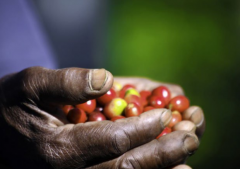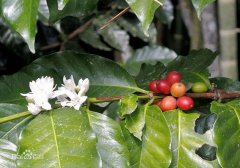What kind of environmental conditions do you need to grow coffee trees? how much is the Alishan mocha coffee?
The origin of the coffee tree is Ethiopia in Africa. In botany, coffee trees belong to the evergreen trees of the subgenus Rubiaceae, and coffee beans, commonly known as coffee beans, are the seeds of the fruit of coffee trees, just because they are shaped like beans, so they are called coffee beans.
Climate is the decisive factor for coffee cultivation. Coffee trees are only suitable for growing in the tropics or subtropics, so the zone between latitude 25 degrees south and north is the most suitable for growing coffee. This coffee production zone is generally referred to as "coffee belt" or "coffee area".
However, not all the land located in this area can cultivate good coffee trees. The ideal planting conditions for coffee trees are: a warm climate with a temperature of 15-25 ℃, and a rainfall of 1500-2000 mm throughout the year, and the rainfall time should be consistent with the flowering cycle of the coffee tree. Of course, in addition to the coordination of seasons and rainfall, there should be fertile soil. The most suitable soil for growing coffee is a well-drained, fertile soil containing volcanic ash.
In addition, although sunlight is an indispensable element for the growth and fruiting of coffee, too strong sunlight will affect the growth of coffee trees, so various producing areas will usually cooperate with the planting of some sunshade trees. generally plant higher trunk plants such as bananas, mangoes and legumes. The ideal altitude is 500-2000 meters above sea level. Therefore, the quality of Jamaican Blue Mountain coffee, which grows at an altitude of 8-1200 meters, is the best. It can be seen that the conditions for cultivating high-quality coffee are very strict: sunlight, rainfall, soil, air temperature, as well as the way coffee beans are harvested and the process of making coffee beans will affect the quality of coffee itself.

Important Notice :
前街咖啡 FrontStreet Coffee has moved to new addredd:
FrontStreet Coffee Address: 315,Donghua East Road,GuangZhou
Tel:020 38364473
- Prev

Country of production: Zimbabwe planting area: Chipingai Dandoni Farm
Commercial coffee cultivation in Zimbabwe began in the 1960s. The coffee produced here, like many East African coffee, has a good balance, complex variability, as well as good bean shape and processing technology. Zimbabwe AA-Dandoni Village producing country: Zimbabwe Grade: AA planting area: Qipinggai Factory label: Dandoni Farm treatment method: wet processing outside
- Next

The coffee grown in Papua New Guinea is mainly Indonesian Tibica sweet coffee.
Coffee grown in Papua New Guinea is mainly Indonesian Tibica, which is mainly grown in the east and west of Papua New Guinea. The coffee cultivation in Papua New Guinea is quite unique, and a method called coffee garden is often adopted here, and coffee farmers tend to plant coffee trees around their houses at will. The land of Papua New Guinea is very fertile, and the excellent climatic conditions allow
Related
- Does Rose Summer choose Blue, Green or Red? Detailed explanation of Rose Summer Coffee plots and Classification in Panamanian Jade Manor
- What is the difference between the origin, producing area, processing plant, cooperative and manor of coffee beans?
- How fine does the espresso powder fit? how to grind the espresso?
- Sca coffee roasting degree color card coffee roasting degree 8 roasting color values what do you mean?
- The practice of lattes: how to make lattes at home
- Introduction to Indonesian Fine Coffee beans-- Java Coffee producing area of Indonesian Arabica Coffee
- How much will the flavor of light and medium roasted rose summer be expressed? What baking level is rose summer suitable for?
- Introduction to the characteristics of washing, sun-drying or wet-planing coffee commonly used in Mantenin, Indonesia
- Price characteristics of Arabica Coffee Bean Starbucks introduction to Manning Coffee Bean Taste producing area Variety Manor
- What is the authentic Yega flavor? What are the flavor characteristics of the really excellent Yejasuffi coffee beans?

